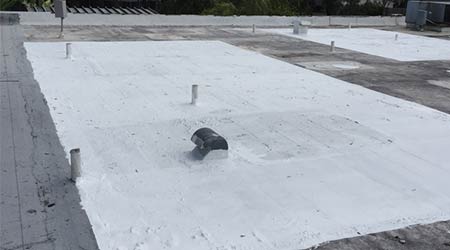Roof Assessments: The Repair, Recover and Replace Dilemma
Part one of a four-part article on roof assessments
Managing roofing systems is one of the most complex tasks facing engineering and maintenance managers with institutional and commercial facilities. The combined effects of weather, time, and foot traffic, among other factors, combine to wreak havoc on roofing systems and their components.
Unfortunately, many managers opt to do little, if anything, when it comes to roof management. They ignore their roofs — at least until someone notices a water leak. But waiting until a roof leaks is the worst move a manager can make. By that point, the damage has been done to the roof and its components, as well as to the building’s contents and its operations. It is far better to invest time and money over the life of the roof than to wait until it actually fails.
Inevitably, the condition of roofs will present managers with three options — repair, recover, or replace. If the decision is to replace, what does a manager replace the existing roof with — the same type of roof or a completely different type?
To make this and related decisions, managers need data. A comprehensive inspection and maintenance program can provide them with information on the roof’s condition that will help them make sound decisions that can extend the life of a roof and often can double it. By understanding the condition of their roofs and the available roofing options, managers can make the most appropriate decision for their particular application.
A roof condition assessment begins with a review of the roof’s historical records. When was the roof installed? Was it the original roof or a replacement? If it is a replacement roof, was the original roof completely removed, or was the new roof installed over the existing one?
Next, managers should review the roof’s history of repairs and inspections. Technicians should inspect all roofs twice annually — in the spring and again in the fall. They should conduct additional inspections following severe weather that might damage the roof.
Managers can review the inspection data to identify trends or the development of new issues related to the roof’s condition. Reviewing the data also will help identify corrective maintenance activities workers can take to address the problem.
A review of the roof’s maintenance records also will provide information on the roof’s condition and help identify trends. Are the roof’s maintenance requirements increasing, decreasing, or remaining relatively flat? What types of defects are occurring? Do the same defects show up in the maintenance records in the same location? Are workers performing the proper repair activities?
Managers also must consider such factors as the amount of time occupants use the building, whether they need regular access to the roof for their activities, and whether the organization has plans for the building’s renovations or even demolition.
All of these issues can give managers a general feeling for the condition of a building’s roof and the need for repair or replacement. But if it is beginning to look like the roof is approaching the end of its service life, they will need more detailed information.
Related Topics:
















